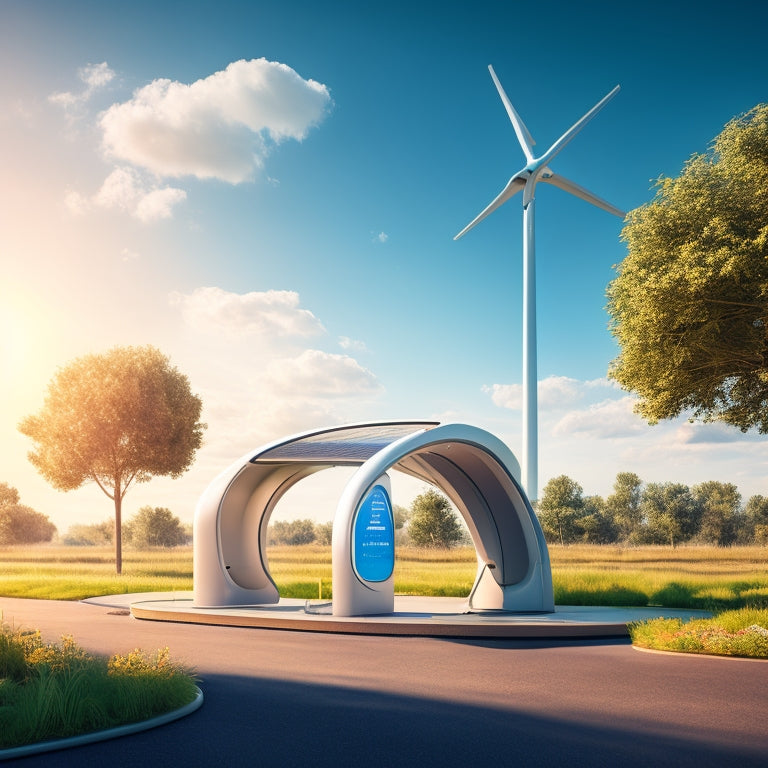
Eco-Friendly EV Charging Station Designs With Renewable Energy
Share
You can design eco-friendly EV charging stations that integrate renewable energy sources, such as solar power, to reduce reliance on the grid and minimize carbon footprint. Incorporate solar panels or wind turbines to generate clean energy, and consider sustainable design elements like living walls, green roofs, and energy-efficient lighting. Renewable energy storage systems guarantee a stable power supply, and energy-efficient charging technology minimizes energy losses. By offsetting energy consumption with on-site renewable energy, you can create a net zero emissions charging site. As you explore these innovative designs, you'll discover even more ways to create a sustainable EV charging infrastructure.
Key Takeaways
• Eco-friendly EV charging stations integrate solar energy harvesting systems to tap into limitless solar power for electric vehicles.
• Sustainable station design elements include living walls, green roofs, energy-efficient lighting, and rainwater harvesting for a holistic eco-friendly design.
• Renewable energy storage systems, like battery swapping systems, guarantee a stable power supply for EV charging infrastructure and reduce grid reliance.
• Energy-efficient charging technology, such as fast charging and smart grid integration, minimizes energy losses and optimizes energy distribution.
• Net zero emissions charging sites can be achieved by offsetting energy consumption with on-site renewable energy, reducing carbon footprint and reliance on the grid.
Harnessing Solar Energy for EVs
Your electric vehicle can now tap into the limitless power of the sun, thanks to innovative EV charging station designs that integrate solar energy harvesting systems.
These cutting-edge stations can be connected to nearby solar farms, allowing you to fuel up on clean energy.
As energy policy continues to evolve, it's likely that we'll see more incentives for EV owners who opt for solar-powered charging.
By leveraging the power of the sun, you'll not only reduce your carbon footprint but also minimize your reliance on the grid.
With solar-powered EV charging stations, you'll have greater control over your energy consumption and can drive away with a clear conscience.
As the demand for sustainable energy solutions grows, it's exciting to think about the possibilities that solar-powered EV charging stations will bring.
Sustainable Station Design Elements
As you explore the possibilities of solar-powered EV charging stations, the design elements of these sustainable stations come into focus, incorporating features like energy-efficient lighting and rainwater harvesting systems to minimize their ecological impact.
Sustainable station design elements prioritize eco-friendliness, incorporating features like:
| Design Element | Description |
|---|---|
| Living Walls | Vertical gardens providing natural insulation and air purification |
| Green Roofs | Vegetated roofs reducing urban heat island effect and stormwater runoff |
| Energy-Efficient Lighting | LED lighting minimizing energy consumption and carbon footprint |
| Rainwater Harvesting | Collecting and reusing rainwater for non-potable purposes |
These design elements work together to create a holistic, eco-friendly EV charging station that not only supports sustainable transportation but also minimizes its own environmental impact. By incorporating these features, you can create a charging station that's as sustainable as the EVs it supports.
Renewable Energy Storage Systems
Integrating renewable energy storage systems into your EV charging station design allows you to store excess energy generated by on-site solar panels or wind turbines, reducing reliance on the grid and minimizing downtime during outages.
By incorporating energy storage systems, you can guarantee a stable and consistent power supply for your EV charging infrastructure. This is particularly important for high-power charging applications, where energy demand can be high.
Consider integrating battery swapping systems, which allow for quick replacement of depleted batteries with fully charged ones, minimizing downtime.
Additionally, hydrogen fueling infrastructure can be integrated with on-site renewable energy generation, providing a clean and efficient fueling solution.
Solar Panel Array Configurations
When setting up your solar panel array, you'll need to take into account factors such as panel orientation, tilt, and spacing to maximize energy output and optimize the performance of your EV charging station.
Proper panel angles are vital, as they affect energy production. A tilt between 30° to 40° is optimal for most locations.
You'll also need to take into consideration mounting systems, which can be roof-mounted, ground-mounted, or tracking systems. A well-designed mounting system guarantees durability and ease of maintenance.
Energy-Efficient Charging Technology
You'll want to incorporate energy-efficient charging technology into your EV charging station to minimize energy losses and reduce your station's overall carbon footprint.
Fast Charging capabilities will enable rapid replenishment of EV batteries, reducing wait times and increasing user satisfaction.
Integration with Smart Grids will optimize energy distribution and consumption, ensuring a seamless charging experience.
Vehicle Integration will facilitate real-time communication between EVs and the charging station, allowing for efficient Power Management.
By leveraging these advanced technologies, you'll create a high-performance charging station that minimizes energy waste and supports a sustainable transportation ecosystem.
Grid-Independent EV Charging Hubs
As you explore grid-independent EV charging hubs, you'll discover the importance of energy harvesting systems that can collect and convert renewable energy from sources like solar or wind power.
These systems enable charging stations to operate off the grid, reducing reliance on non-renewable energy sources.
Energy Harvesting Systems
Grid-independent EV charging hubs, equipped with energy harvesting systems, can greatly reduce reliance on the grid and operating costs by leveraging on-site renewable energy generation.
As you design your EV charging station, consider incorporating wind turbines to generate electricity from wind energy. This clean energy source can power your charging stations, reducing your carbon footprint.
Additionally, you can explore bioenergy solutions, such as anaerobic digestion or biomass combustion, to generate electricity from organic matter. By integrating these energy harvesting systems, you'll decrease your dependence on the grid and minimize your environmental impact.
With on-site renewable energy generation, you'll have greater control over your energy costs and contribute to a more sustainable future.
Off-Grid Power Solutions
By leveraging off-grid power solutions, EV charging stations can operate independently of the grid, providing a reliable and sustainable source of energy for electric vehicles. As you consider off-grid power solutions, you'll find they're particularly useful for wilderness installations or rural electrification projects where traditional grid connections are limited or non-existent.
Here are three key benefits of off-grid power solutions:
-
Energy autonomy: Off-grid systems allow EV charging stations to generate their own energy, reducing reliance on the grid and minimizing the risk of power outages.
-
Cost savings: By harnessing renewable energy sources, you can notably reduce operating costs and minimize your carbon footprint.
-
Flexibility and scalability: Off-grid power solutions can be easily scaled up or down depending on your energy needs, making them an ideal choice for remote or hard-to-reach locations.
Green Building Materials and Design
As you design an EV charging station, you'll want to incorporate sustainable building practices that minimize environmental impact.
You'll need to select green building materials that are locally sourced, recycled, or recyclable to reduce waste and conserve natural resources.
Sustainable Building Practices
Integrating sustainable building practices into EV charging station design involves evaluating materials and designs that minimize environmental impact, reduce waste, and promote energy efficiency. You'll want to take into account the entire lifecycle of the station, from construction to operation and maintenance. This approach can greatly diminish the station's ecological footprint.
Here are some key strategies to incorporate:
-
Water Conservation: Implement low-flow fixtures and greywater reuse systems to minimize water waste.
-
Waste Reduction: Opt for recyclable and reusable materials, and implement recycling programs for waste generated during construction and operation.
-
Material Selection: Choose materials with low embodied energy, high recycled content, and locally sourced materials to reduce transportation emissions.
Energy-Efficient Design Elements
You can greatly decrease the energy consumption of your EV charging station by incorporating energy-efficient design elements, including green building materials and design strategies that minimize energy waste.
For instance, using insulated walls and roofs can reduce heat loss and gain, reducing the need for heating and cooling. Aerodynamic Shelters can also help reduce wind resistance, further minimizing energy consumption.
Additionally, incorporating Ventilation Systems can improve air quality and reduce the need for air conditioning. By incorporating these design elements, you can create an energy-efficient EV charging station that not only reduces your carbon footprint but also saves you money on energy costs.
Net Zero Emissions Charging Sites
Designing net zero emissions charging sites involves offsetting the energy consumption of EV charging stations by generating an equivalent amount of renewable energy on-site or locally. You can achieve this by incorporating on-site renewable energy systems, such as solar panels or wind turbines, to power your EV charging station. This approach not only reduces your carbon footprint but also provides a sustainable solution for EV owners.
Here are three key strategies to take into account:
-
Carbon offsetting: Calculate your station's carbon emissions and invest in renewable energy projects to offset them.
-
Urban planning: Locate your station in areas with high foot traffic and proximity to public transportation, reducing the need for personal vehicles.
-
Energy storage: Incorporate energy storage systems to store excess energy generated on-site, reducing reliance on the grid.
Frequently Asked Questions
Can EV Charging Stations Be Powered Solely by On-Site Renewable Energy?
You can achieve energy autonomy by powering EV charging stations solely with on-site renewable energy through effective renewable integration, allowing you to reduce reliance on the grid and minimize your carbon footprint.
How Do Energy Storage Systems Mitigate Grid Strain From EV Charging?
You can mitigate grid strain from EV charging by leveraging energy storage systems, which provide grid resiliency through peak shaving, reducing strain during peak hours and ensuring a stable, reliable energy supply.
Are There Any Government Incentives for Building Eco-Friendly EV Charging Stations?
You can leverage various government incentives, such as Tax Credits, Green Grants, Federal Subsidies, and State Rebates, to offset the costs of building eco-friendly EV charging stations, making your project more financially viable.
Can Existing Gas Stations Be Retrofitted With EV Charging Infrastructure?
You're wondering if existing gas stations can be retrofitted with EV charging infrastructure. Yes, it's possible, but you'll face retrofitting challenges, such as reconfiguring the station layout to accommodate charging stations and ensuring electrical infrastructure can support the added load.
How Do Eco-Friendly EV Charging Stations Reduce Urban Heat Island Effects?
You can reduce urban heat island effects by incorporating urban forestry and heat mitigation strategies in EV charging station designs, such as installing green roofs, trees, and cool pavement to minimize heat absorption.
Related Posts
-

What Cool Roof Tax Breaks Can Homeowners Claim?
You can claim federal tax credits of up to $500 and state and local incentives for installing cool roofs, which not o...
-

10 Grid-Tied Wind Power Systems for Modern Homes
You're looking for a grid-tied wind power system to utilize wind energy for your modern home. Here are ten options to...
-

10 Green Waste Solutions Every Homeowner Should Know
You can make a significant impact on the environment by implementing green waste solutions at home. Consider composti...


